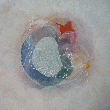Moving forward with the GIF animations I have been doing much experimentation; creating sequences and cycles. There is so much to explore just in this very simple format, which can potentially be projected onto a wall – it offers itself to a boundless scaling up or down, to treatment according to the nature of a specific space or site. It is like the paintings are doing a performance of themselves – they are let loose to say “look what we really are, see how much we contain, we are boundless.”
I like the crudeness and simplicity of the GIF format. It is in contrast with the fineness of the paintings which takes weeks and months to achieve. From now on I think I shall be calling the GIF animations Timelines, as I did a few posts back. I can them identify each Timeline specifically, or otherwise, group them perhaps. I find that looking at a wall (etymology) of these Timelines is engaging, just in itself. I hope to be able to convey a sense of this below with some random GIFS from my library. I remind myself that this is only easy and possible using the digital as tool, so even though I remain rooted in the making of paintings in this studio, I see the world of the painting as opening out considerably already ; and I have only just begun with this relative to the many years I have invested in painting. This all seems to suggest that the MA Fine Art Digital is the one and only course for me. I am so grateful that it exists, that Jonathan Kearney invented it, that it offers me a platform to extend my painting in a new way. My painting in itself is already a richness, having undergone such a huge evolution over the years, which has been a relentless matter of persistence and determination throughout, I have been reclusive by necessity. It is good to feel newly connected, and the wall below suddenly feels like a proclamation and celebration of it, it is perhaps, after all, the poem so far.












Note to Self:
Looking at this wall, imagining myself as the audience, would I actually immediately realise that these are actually images of paintings? Is it possible that the viewer, one perhaps completely new to looking at paintings, might, when they see that this is all based on single paintings, want to and then ask to see the paintings themselves directly? In which case they would be meeting the paintings with a prior knowledge of their content, already familiar. Would this actually address a fundamental problem with painting itself – that unless the viewer is informed, they may feel the need of a third party “expert” interpretation of the work to be able to engage with it directly? The paintings can always be seen first and the Timelines after but the scenario of the Timelines first is perhaps more revealing?